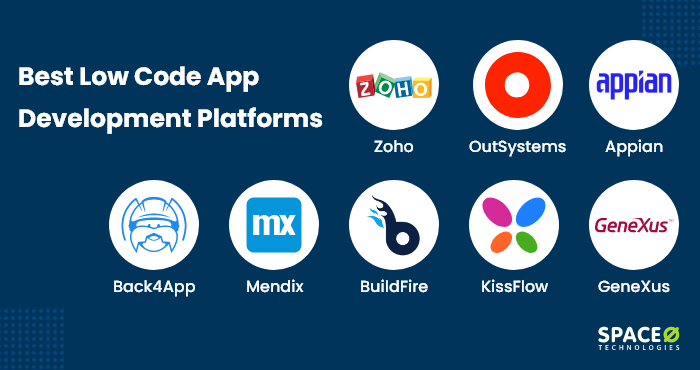Visual Development Environment:
Drag-and-Drop Interfaces: Low-code platforms provide visual tools for designing applications. Drag-anddrop components enable developers to build apps quickly without having to write code.
Pre-built Components and Templates: A lot of platforms that support low-code come with components and pre-built template that allow developers to build prototypes quickly and build applications without having to start completely from the beginning.
Reduced Coding Needs:
Automated Generated Code: Lowcode platforms generate the code base on the visual models created developers. This helps reduce manual code, and speeds the process of developing.
Reusable components: Developers are able to reuse components across multiple projects, which reduces the time they're creating and evaluating code.
Collaboration is made easier:
Low-code platform tools typically contain versions control, testing deployment. This allows for the seamless communication between teams.
Citizen Development: Users of businesses and non-developers can help with application development using intuitive interfaces, thus reducing bottlenecks that is often caused by the limited availability of professional developers.
Rapid prototyping and iteration
Rapid prototyping: Developers are able to quickly create prototypes in order to gather feedback and validate ideas, which results in quicker iterations.
Simple modifications. The visual interface low-code development offers makes it simple to modify and update applications. This speeds up the process of improving and refining the application based on feedback from users.
Pre-built Integrations:
API Integrations: Low-code platforms are often pre-built with connectors for popular services and APIs. This can reduce the time needed to integrate external systems.
Data Integration: The built-in tools make it easier for connecting with databases and other sources, speeding the process of development.
Deployment and Scaling
One-Click deployment: A lot of platforms that make use of low-code have a one-click option for deploying applications, thus reducing time and effort.
Cloud-Based Solutions: Cloud-based low-code platforms can manage infrastructure and scaling which allows developers to concentrate on the logic of their applications and functions rather than deployment logistics.
Overall, low-code development has the advantage in terms speed due to its ability of automatizing and simplifying a variety of elements of development. This allows for faster app delivery and a simpler adapting to the changing demands. Read the top updated blog post about Low-code Platform for application development for blog tips including database in azure, app development platform, rad development, app modernisation, microsoft azure sql, cross platform mobile app development, application modernization software, application modernization software, app modernization, low code platforms and more.

Low-Code App Development Has Numerous Benefits, Particularly In The Area Of Cost-Effectiveness.
Low-code applications offer a variety of advantages when it comes to cost-effectiveness. Businesses seeking to reduce costs are able to benefit from this method while still delivering high-quality applications. Here are a few of the major benefits:
Reduced Coding: Low-code platforms cut down on the amount of hand-coding required which saves developers time and energy in the process of creating applications. The result is lower labour costs.
Fewer Developers: Because low code development is speedier and easier to develop, there are less specialized developers needed. This reduces the need for hiring and personnel costs.
Quicker time to market:
Accelerated development cycle: Visual development tools as well as prebuilt components that are provided by low-code platforms facilitate rapid application development. This allows companies to get their products to go to market faster. This can lead faster revenue growth and improve your position in the marketplace.
Rapid prototyping. Through the rapid creation and testing prototypes, businesses can cut down on time spent development and iterate faster based upon user feedback.
Lower Maintenance Costs:
Simpler maintenance: Low-code platforms, with their modular design and components that are standardised can be maintained more easily. This reduces the cost of ongoing maintenance and support.
Automated Updates - A lot of low-code platforms are capable of managing updates and patches in a manner that's as secure as well as timely. This means that there is no necessity for manual intervention.
Efficient Resource Utilization:
Low-code platform contributions let both business users and others who are not developers to take part in the process of creating. This democratization allows businesses to utilize the talents of their employees and decrease the dependence on high-paying programmers.
Optimized Use of IT Resources: IT departments can focus on more strategic initiatives instead of being slammed with routine development tasks, improving overall productivity and efficiency.
Price models that are scaleable:
Subscription Pricing: A lot of platforms with low-code support flexible pricing models that are based on subscriptions that are scaled according to usage. This allows businesses to make sure that their budget is in line with their needs and grow.
Pay-As-You-Go options Certain platforms allow businesses to pay only for what they use. This is particularly beneficial for startups or small businesses with a limited budget.
Reduction in Third-Party Software Fees:
Built-in Functionalities : A low-code software usually comes with built-in functionality and integrations which reduces the need for extra third-party software, tools, and licenses.
Pre-Built Intergrations: The ability to use pre-built integrations and pre-built integrations for popular systems and services reduces the requirement for custom development, and helps save time and money.
Higher ROI
A faster return on investment (ROI) by making use of the rapid development process, less expense and a quicker time to the market, companies are able to achieve an increase in ROI for their applications.
Enhanced Agility. Companies will be able to adapt quickly to evolving market conditions and consumer demands. This will allow them to stay relevant and will be able to profit from any new opportunities.
Costs of training are lower:
User-friendly interfaces: Low-code systems provide user-friendly and easy interfaces that reduce the time required to learn. They also minimize the requirement for long-running training programs.
Accessible Resources: Many platforms using low-code provide an extensive range of instructional materials, tutorials, and support for community members. This means that there is less necessity for formal education, as well as the costs associated with it.
Collaboration Streamlined:
Improved Collaboration Tools : The collaboration tools built-in to the software help in communication and coordination among team members. This results in an efficient development process and lower overhead.
Unified Development Environment: A single integrated development environment helps improve workflows and reduces cost and complexity of managing multiple tools and platforms.
In general, low-code apps are cost-effective because of their ability to cut costs of development and maintenance as well as to speed time-to-market, to maximize resource use, and to provide an affordable pricing. Low-code can provide significant financial benefits for companies. See the best sources tell me about Legacy application modernization with Low-code for website examples including push alerts, develop cross platform mobile app, developing mobile apps, cross platform app dev, app development platform, ms azure sql, software for app development, driver jdbc, application modernisation, push alerts and more.

The Benefits Of Developing Low-Code For Collaboration And Workflow
The low-code method of developing applications has several benefits in terms of workflow and collaboration, which makes it a great choice for companies looking to boost team productivity and speed up their process of development. These are the main advantages.
Unified Development Environment Low-code platform provides an all-in-one environment in which all employees, including developers, analysts as well as designers, stakeholders, and more, can efficiently work together. They remove silos while encouraging greater communication.
Visual Development Tools: The visually drag-and-drop design of low-code platforms makes it easier for team members who are not technical to take part in the process of development, while ensuring that the requirements of the business are correctly captured and implemented.
Improved Communication
Real-Time Collaboration: Many low-code platforms offer real-time collaboration features including simultaneous editing, commenting and instant feedback, which enable continuous communication and cut down on the time wasted in back-andforth discussions.
Shared Workspaces: Teams may work together in shared workspaces, in which they can review, edit, and discuss project components, ensuring everyone is on the same page and pursuing the same goals.
Workflow management simplified:
Built-in Tools for Project Management: Platforms that are low-code typically come with integrated project management tools that aid teams in planning and track their development initiatives. This includes tasks assignment tracking progress, task assignment, and deadlines management.
Workflow Automation - Automating repetitive tasks or workflows allows teams to concentrate their efforts on more strategic projects and activities, improving the efficiency overall of an organization.
Speedier Iteration Cycles
Rapid Prototyping Low-Code platforms are ideal for quick prototyping. Iterative development is also feasible which allows the team to develop, test and improve their apps within shorter time. This enables feedback to be incorporated quickly into the application, and for rapid enhancements.
Agile Development Support : Support of agile practices lets team members develop sprints. They are able to continuously provide small improvements in functionality and more easily adapt to changing requirements.
Accessibility to Non-Developers
Citizen-driven development platforms enable business users to modify and create applications without extensive programming knowledge. This lets IT and development teams to focus on other areas and respond faster to business demands.
Onboarding and Training. The user-friendly interfaces of training tools help new members to become familiar with the system, and this enhances teamwork.
Centralized documentation and sharing of knowledge
Integrated Documentation: Low-code platforms often include features for creating and maintaining documents within the platform itself, ensuring that all project information is easily accessible and centrally located.
Knowledge Repositories: Teams may build and maintain knowledge repositories that contain best practices, templates, and reusable components, which aid in knowledge sharing and reducing duplication of effort.
Consistency and Standardization
Standardized Components: The use of standardized, pre-built components provides the sameness across applications and makes it easier for team members to comprehend and collaborate on various aspects of the project.
Governance and Governance and Compliance: Built-in governance structures ensure that every development is in line with the organizational guidelines and regulations which reduces the chance of non-compliance, and ensuring that applications adhere to high-quality standards.
Feedback and Improvement Loops:
Integrated Feedback Mechanisms Low-code platforms usually have integrated feedback mechanisms, which allow users to easily provide feedback on the application, which can then be incorporated into the process of development.
Continuous Improvement: The capability to rapidly iterate on and deploy modifications in response to feedback ensures the continuous improvement of the applications. They are closely aligned to the requirements of users as well as business objectives.
Visualization, Reporting and Analyzing:
Real-Time Analyses: The built-in reports and analytics tools offer real-time insight into the project's progress, performance and user interactions, making it possible to make data-driven choices.
Visual Workflow Mapping: Visual tools to map workflows can be used by teams to improve workflows. This allows them to identify the bottlenecks, as well as areas of improvement.
Low-code application development is a powerful tool to collaborate and streamline workflow. It brings together different teams, simplifies communication and automates processes. This promotes a more agile, collaborative and efficient environment for development. This eventually results in better-quality applications as well as better alignment of business goals.
